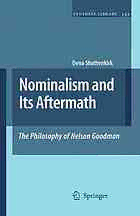
Nominalism and its aftermath: the philosophy of Nelson Goodman PDF
Preview Nominalism and its aftermath: the philosophy of Nelson Goodman
NOMINALISMANDITSAFTERMATH SYNTHESE LIBRARY STUDIESINEPISTEMOLOGY, LOGIC,METHODOLOGY,ANDPHILOSOPHYOFSCIENCE Editor-in-Chief: VINCENTF.HENDRICKS,RoskildeUniversity,Roskilde,Denmark JOHNSYMONS,UniversityofTexasatElPaso,U.S.A. HonoraryEditor: JAAKKOHINTIKKA,BostonUniversity,U.S.A. Editors: DIRKVANDALEN,UniversityofUtrecht,TheNetherlands THEOA.F.KUIPERS,UniversityofGroningen,TheNetherlands TEDDYSEIDENFELD,CarnegieMellonUniversity,U.S.A. PATRICKSUPPES,StanfordUniversity,California,U.S.A. JANWOLEN´SKI,JagiellonianUniversity,Krako´w,Poland VOLUME343 Forfuthervolumes: www.springer.com/series/6607 NOMINALISM AND ITS AFTERMATH THE PHILOSOPHY OF NELSON GOODMAN by DenaShottenkirk Brooklyn,NY,U.S.A. 123 Dr.DenaShottenkirk 360PresidentStreet BrooklynNY11231 USA d [email protected] ISBN 978-1-4020-9930-4 e-ISBN 978-1-4020-9931-1 DOI 10.1007/978-1-4020-9931-1 SpringerDordrechtHeidelbergLondonNewYork LibraryofCongressControlNumber:2009926951 (cid:2)c SpringerScience+BusinessMediaB.V.2009 Nopartofthisworkmaybereproduced,storedinaretrievalsystem,ortransmittedinanyformorby anymeans,electronic,mechanical,photocopying,microfilming,recordingorotherwise,withoutwritten permissionfromthePublisher,withtheexceptionofanymaterialsuppliedspecificallyforthepurpose ofbeingenteredandexecutedonacomputersystem,forexclusiveusebythepurchaserofthework. Coverdesign:BoekhorstDesignBV Printedonacid-freepaper SpringerispartofSpringerScience+BusinessMedia(www.springer.com) EmilyMichael,Ingratitudeforherintellectual guidance andmoralsupport Preface Nelson Goodman’s disparate writings are often discussed and written about only within their own particular discipline, such that the epistemology is discussed in contrast to others’ epistemology, the aesthetics is contrasted with more traditional aesthetics,andtheontologyandlogicisviewedinoppositiontobothothercontem- poraryphilosophersandtohishistoricalpredecessors.Thisbookarguesthatthatis notanadequatewaytoviewGoodman. Goodman’sfirstandseminalbook,TheStructureofAppearance(SA),whichwas publishedin1951thoughitwasarevisedversionofhis1941Ph.D.dissertation,sets forthnotonlyhislogicandnominalistontology,butistheframeworkuponwhich he builds the rest of his work and thus the rest of his work cannot be adequately understood without a grounding in his ontology. This applies to understanding his epistemology but it is even truer in understanding his aesthetics. His epistemol- ogy, developed thirteen years after The Structure of Appearance, which detailed his ontology and logic, is heavily dependent on that ontology and logic. And his aesthetics,primarilycapturedinLanguagesofArt,writtentwenty-sevenyearsafter SA,isitselfdependentuponbothhisepistemologyandhisontologicalcommitment tonominalism.Inshort,NelsonGoodman’saestheticscannotbeunderstoodwith- out prior knowledge of both his epistemology and his ontology, in particular his nominalism.Furthermore,thisbookalsoassertsthatitistheveryconsistencywith whichheappliedhisnominalismthatresultedinthedifficultiesencounteredinboth hisepistemologyandhisaesthetics. Inordertodemonstratebothpoints–firstly,thedependencyofhisepistemology and aesthetics on his early metaphysical and ontological writings, and secondly, that it is the very application of those metaphysical and ontological positions to the rest of his philosophical writings that is the source of much of which fails to be completely satisfactory – the book has been divided into three sections: The Metaphysics,TheEpistemology,TheAesthetics.Theyaresequentialsectionswith eachprovidingthegroundrulesforthenextsectionand,furthermore,providingthe reasonsforlimitationsonthetermsavailabletothesubsequentsection(s).Thusthe Metaphysics is an explication of Goodman’s basic nominalist ontology and logic, anditisuponthoseprinciplesthathebuildshisepistemology.Itisthesumofboth themetaphysicsandtheepistemology,withthenominalistprincipleastheguiding force, which constructs the aesthetics. At the end of each section, the consequent vii viii Preface limitationsimposedonhistermsandconceptsavailabletohimareexplicated,such that,bytheendofthebook,Iamabletodelineatetheconstraintsimposeduponthe aestheticsbyboththemetaphysicsandtheepistemology. Thisshortintroductionwillprovide,Ihope,thebasicthoughtsdrivingthebook andgivethereaderthegeneralframeworkofthearguments.Thefundamentalpre- ceptofthebookisthatGoodmanis,morethananythingelse,anominalist,granting onlyentitiesofthelowestontologicalkind,necessitating,forexample,adefinition of “property” as the typically repeated pattern of qualia exhibited by an object, instead of an essentialist trait. Entities are defined not only as individuals but in extensionalist terms to such an extent that, by his own account, Goodman was a “super-extensionalist”. His particular form of nominalism has fundamental consequences first in his epistemology, which cannot itself be adequately understood apart from his ontol- ogy for it is in his “calculus of individuals” that he defines qualia (presentation of color,time,andspace)asthephenomenalbasicunits–entitiesthatsatisfythebasic adequacycriterionforsystemsingeneral,anditisfromthesebasicprimitivesthat the constructionalism can, with a limited set of terms and operations, be used to buildanontologicalorepistemologicalsystem. Goodman’s nominalism has the consequences of forbidding not only (Platon- ist) properties, but also abstract objects, meaning accounts, classes, and fictive reference as well. All of these constraints are directly translated in his epistemol- ogy where his commitments involve denials of universal/objective truth, natural kinds, the autonomous object, and univocal human responses. It is an epistemol- ogy wherein empiricism is denied and coherentism embraced, objective reality is denied and replaced by relativistic worldmaking, and induction and the pro- jection of predicates is given the central role in the formation of all knowledge systems. CentralalsotoallofGoodman’sphilosophyisreference:weunderstandbycor- rectly ascertaining the relation between a symbol and the thing symbolized. This istrueforbothartandscienceinthatweunderstandbothbysortingthesymbols. Hence, Goodman’s aesthetic symbols refer in ways that can only be understood withinthegeneralframeworkoftherestofhisphilosophy. Thusthecumulativesumofhismetaphysicsandhisepistemologyisseeninthe final section of the book – the aesthetics. There it will be shown that Goodman’s aesthetics,whichisasemanticaccountofreference,forbidsintensions,properties, fictiveentities,non-semanticmeaning,naturalsymbols,acentralroleforemotion, and any notion of a universal or empirical truth, and that those restrictions on the termsandfunctionsavailabletohimarethedirectresultofhisepistemology,which, torepeat,arguesforrelativism,pluralism,andworldmaking. And to reiterate the recursive reasoning, these restrictions are the direct result ofhismetaphysicsandontology.Inshort,theGoodmaniansystemisaremarkably well-integrated and tightly knit whole with nominalism functioning as the foun- dation and glue; but it is a glue that is, as the saying goes, both a blessing and a curse. Preface ix At the close of this preface I don’t want to leave unmentioned my gratitude to mychildren,Merida,Dodge,andArliss,whohavebeenendlesslytolerantandgen- uinely supportive through this long process (do they ever remember a time when NelsonGoodmanwasnotintheirlives?).IalsowanttothanktheGlasgowSchool ofArtforgivingmethetimenecessarytocompletethisprojectandforcreatinga workatmospherethatencouragedmetopushforward. Brooklyn,NY DenaShottenkirk
